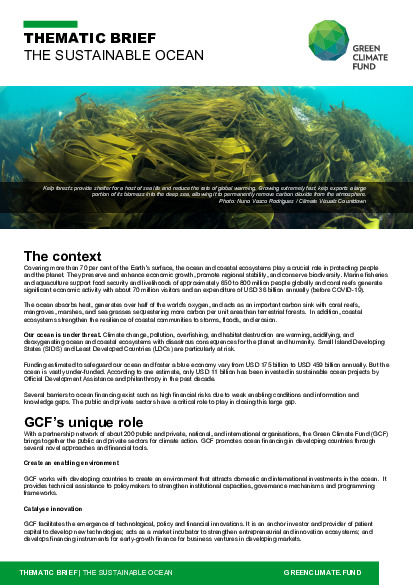Thematic brief: Oceans
Oceans and coastal ecosystems cover more than 70 percent of the Earth’s surface, providing a natural asset of enormous significance to protect our planet, preserve and enhance local economic growth, promote regional stability and conserve global biodiversity. This generates vital ecosystem goods and services that support our future, such as climate and temperature regulation, absorption of carbon emissions, fisheries, food security, coastal protection, tourism services and jobs. Marine fisheries and aquaculture produce about 15 percent of the animal protein consumed by 4.3 billion people while supporting the livelihoods of approximately 650 to 800 million people globally.
Oceans absorb heat, generate over half of the world’s oxygen and act as an important carbon sink. They have significant role in carbon stock enhancement as coral reefs, mangroves, marshes and sea grasses can sequester more carbon per unit area than terrestrial forests. At the same time, these coastal ecosystems strengthen communities’ resilience to storms, floods, and coastal erosion, and ensure a steady stream of economic benefits including job creation, poverty alleviation and improved health. Coral reefs can generate significant economic activity attracting an estimated 70 million visitors annually with an associated expenditure of US $36 billion (prior to COVID-19). Up to half of the world’s coral reefs have been lost, and if global temperatures rise by 1.5°C, 90% could disappear3, jeopardizing one of the richest sources of biodiversity on Earth and the livelihoods of hundreds of millions of people.
The 2019 IPCC Report on Oceans and the Cryosphere4 reported significant global impacts on marine ecosystems. Coral reefs for instance are facing unprecedented pressure from sea temperature increase and acidification which will have major impacts on ecosystem services and the people dependent upon them. Despite the urgent need to protect the ocean’s natural mitigation and adaptation services, there is a widening financing gap to maintain and enhance ecosystems, whilst providing finance to local communities, especially those living in coastal areas of small island states, to build resilience to the impacts of climate change.
On the supply side, financiers find projects to be too risky while on the demand side, entrepreneurs face a range of policy, institutional and technical barriers to convert investment opportunities into bankable projects. To close the gap, innovative financial instruments and structuring are needed, as well as technical assistance. This includes an optimal mix of grants and non-grant instruments, de-risking financial investments; transformative policy shifts for stimulating technology and innovation to reduce barriers; and new initiatives like blue bonds and debt swaps for climate resilience. These solutions can lead to integrated coastal zone management which helps restore and manage coastal and marine ecosystems – coral reefs, sea grass and seaweed beds, mangroves, coastal and salt marshes – to protect communities from severe weather and sea-level rise while preserving blue carbon ecosystems.
